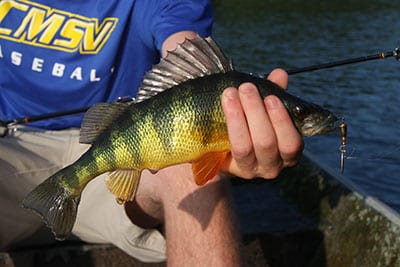
By Tom Schlichter
If you’ve thought about dabbling with ultralight tackle in your freshwater endeavors over the years but never fully acted on the notion, consider April and May the perfect opportunity to rectify that situation. Scaling down your gear is a good way to focus on available early spring options like trout, sunfish, crappies and perch – especially if you live a region where largemouth and bronzebacks are out of season.
The term ultralight is, of course, a relative description where fishing tackle is concerned. For our purposes here, let’s consider it to be spinning setups in the two- to six-pound class with a four-pound class outfit perfect for most freshwater applications. This is far less beefy than serious bass anglers would normally choose, which is exactly what makes it so much fun. Downsizing allows anglers to feel the full fury of smaller battlers, making a big bluegill, crappie or yellow perch feel like a monster at the end of the line. Experience even just a little bit of success with this gear and you’ll quickly find it becomes a major part of your freshwater fishing arsenal throughout the year.
BATTLE TIPS

It’s amazing just how big a fish you can actually land on four-pound test spinning gear. I use light tackle tactics in favorable situations during all four seasons – yes, even when ice-fishing – to land largemouths topping six pounds, pickerel to four-and-a-half pounds, brown trout to four pounds and even a 25-pound carp. In the spring, however, I use my lightweight spinning outfit to specifically target big bluegills, pumpkinseed sunfish, yellow perch and crappies. Even with these species I’ve managed a few trophies, relatively speaking, including an 11-inch bluegill, 15-inch yellow perch and a whopping 17-inch black crappie.
With the ability to present small lures, hooking up is actually one of the least problems for light-tackle enthusiasts. The real challenge is landing your quarry after the strike. For this it helps to have a properly set drag and enough patience to allow a substantial fish to reasonably tire itself out before you try to guide it into a net or lift it from the water.
One mistake anglers frequently make regarding the drag setting is keeping it too loose. The natural instinct is back down the drag setting substantially in the hope of preventing break-offs. Unfortunately, taking this approach will allow your quarry to power off to the nearest snag. Even with ultralight gear, it is important to have enough strength to turn a fish that is heading for heavy cover, so set your drag at about one-third the breaking strength of the line and use your rod tip instead of your drag to dampen sharp lunges and powerful runs.
Be aware, too, that raising your rod tip straight up will increase pressure on a strong fish while pointing the tip at the fish will allow drag to peel more easily from your reel. Thus, you can vary the amount of drag simply by altering your rod angle to make it harder or easier for a fish to peel line.
TOP ULTRA-LIGHT LURES

Nearly as important as how you handle your quarry on light line is choosing where the battle begins. As a rule, light tackle is best suited for use in shallow open water like the mouth of a cove, sandbar edge or slope of a shallow point. Rather than cast into the weeds and heavy cover as you might with studier gear, work lures parallel to weed edges and four to six feet away from blow downs and stick-ups. The idea is to draw the fish out from the snags so that they strike in more open water. Cove mouths, by the way, are especially productive ultralight tackle areas as they are generally open water stretches but still serve as pinch points for roaming fish.
You’ll find a wide variety of lightweight lures actually work better with ultralight gear than they do with more standard fishing tackle. Some of my favorite offerings include Yo-Zuri Allie Goby plugs for big bluegill and pumpkinseed, and size 1 or 2 in-line spinners along the lines of a Mepps Comet, Black Fury Rooster Tail or Blue Fox Super Vibrex for trout, perch and crappies.
Berkley®Johnson® Beetle Spins and Northland® Mimic Minnow® Spins, in the 1/16-ounce size, are exceptional lures for large crappies when buzzed at the surface or just below. Silver and black pattern Rapala, Rebel and Yo-Zuri floating minnows in the two-and-a-half to three-and-a-half inch size tempt crappies, large sunfish and yellow perch. For probing slightly deeper pockets where white perch and an occasional large bluegill are prime targets, it’s tough to beat a one- or two-inch white, yellow or chartreuse curly tailed grub.
While most anglers these days favor braided lines, I still like monofilament for ultra-light fishing. Braid sinks quickly, I find, and that weighs down tiny lures I prefer to have in the upper reaches of the water column this time of year. Also, mono lines stretch considerably whereas braided choices barely stretch at all. That, I believe, gives an edge to the mono as its stretching ability provides a bit of a cushion should the drag be a bit too tight or a big fish power away unexpectedly.









